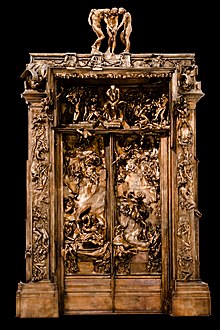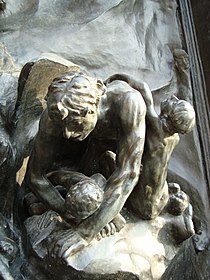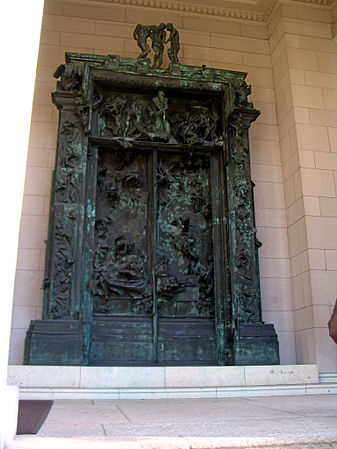A | B | C | D | E | F | G | H | CH | I | J | K | L | M | N | O | P | Q | R | S | T | U | V | W | X | Y | Z | 0 | 1 | 2 | 3 | 4 | 5 | 6 | 7 | 8 | 9
| The Gates of Hell | |
|---|---|
 at the Museo Soumaya | |
| Artist | Auguste Rodin |
| Medium | Bronze |
| Location | Musée D’Orsay, Paris (plaster model); casts in various places |
The Gates of Hell (French: La Porte de l'Enfer) is a monumental bronze sculptural group work by French artist Auguste Rodin that depicts a scene from the Inferno, the first section of Dante Alighieri's Divine Comedy. It stands at 6 metres high, 4 metres wide and 1 metre deep (19.7×13.1×3.3 ft) and contains 180 figures.
Several casts of the work were made, which are now in various locations around the world. Rodin's original plaster model is in the Musée D’Orsay, Paris. The figures range from 15 centimetres (6 in) high up to more than one metre (3 ft). Several of the figures were also cast as independent free-standing statues.
History
The sculpture was commissioned by the Directorate of Fine Arts in 1880 and was meant to be delivered in 1885.[citation needed] Rodin would continue to work on and off on this project for 37 years, until his death in 1917.[citation needed]
The Directorate asked for an inviting entrance to a planned Decorative Arts Museum with the theme being left to Rodin's selection. Even before this commission, Rodin had developed sketches of some of Dante's characters based on his admiration of Dante's Inferno.[1]
The Decorative Arts Museum was never built. Rodin worked on this project on the ground floor of the Hôtel Biron. Near the end of his life, Rodin donated sculptures, drawings and reproduction rights to the French government. In 1919, two years after his death, the Hôtel Biron became the Musée Rodin, housing a cast of The Gates of Hell and related works.[citation needed]
Inspiration
Through me the way into the suffering city,
Through me the way to the eternal pain,
Through me the way that runs among the lost.
Justice urged on my high artificer;
My Maker was Divine authority,
The highest Wisdom, and the primal Love.
Before me nothing but eternal things
Were made, and I endure eternally.
Abandon every hope, who enter here.
Rodin conceived that people would walk toward the work, perhaps up a flight of stairs, and be overwhelmed frontally by the massive gates, contemplating the experience of hell that Dante describes in his Inferno. Rodin thought particularly of Dante's warning over the entrance of the Inferno, "Abandon every hope, who enter here."[2]
A work of the scope of The Gates of Hell had not been attempted before, but inspiration came from Lorenzo Ghiberti's Gates of Paradise at the Baptistery of St. John, Florence, 15th century bronze doors depicting figures from the Old Testament. Another source of inspiration was medieval cathedrals combining high and low relief. Rodin was also inspired by Michelangelo's fresco The Last Judgment, Delacroix's painting The Barque of Dante, Balzac's collection La Comédie humaine and Baudelaire's poems Les Fleurs du mal.[3][4]
In an article in Le Matin, Rodin said: "For a whole year I lived with Dante, with him alone, drawing the eight circles of his inferno. At the end of this year, I realized that while my drawing rendered my vision of Dante, they had become too remote from reality. So I started all over again, working from nature, with my models."[5]
Gallery
- Variations of The Gates of Hell
-
The Kunsthaus Zürich in Zürich
-
The Rodin Museum in Philadelphia
Outstanding figures


The original sculptures were enlarged and became works of art of their own.
- The Thinker (Le Penseur), also called The Poet, is located above the door panels. One interpretation suggests that it might represent Dante looking down to the characters in the Inferno. Another interpretation is that the Thinker is Rodin himself meditating about his composition. Others believe that the figure may be Adam, contemplating the destruction brought upon mankind because of his sin.
- The Kiss (Le Baiser) was originally in The Gate along with other figures of Paolo and Francesca da Rimini. Rodin wanted to represent their initial joy as well as their final damnation. He removed the figure that became known as The Kiss because it seemed to conflict with the other suffering figures.
- Ugolino and His Children (Ugolin et ses enfants) depicts Ugolino della Gherardesca, who according to the story, ate the corpses of his children after they died by starvation (Dante, Inferno, Canto XXXIII). The Ugolino group was cast as a separate bronze in 1882.
- The Three Shades (Les Trois Ombres) was originally 98 cm high. The over-life size group was initially made of three independent figures in 1899. Later on, Rodin replaced one hand in the figures to fuse them together, in the same form as the smaller version. The figures originally pointed to the phrase "Lasciate ogne speranza, voi ch'intrate" ("Abandon all hope, ye who enter here") from Canto III of the Inferno.[6]
- Fleeting Love (Fugit Amor) is located on the right door pane, it is one of several figures of lovers that represent Paolo and Francesca da Rimini. The male figure is also called The Prodigal.
- Paolo and Francesca is shown on the left door pane. Paolo tries to reach Francesca, who seems to slip away.
- Meditation appears on the rightmost part of the tympanum, shown as an enlarged figure in 1896.
- The Old Courtesan is a bronze cast from 1910 of an aged, naked female body. The sculpture is also called She Who Was Once the Helmet-Maker's Beautiful Wife (Celle qui fut la belle heaulmière). This title is taken from a poem by François Villon.
- Fallen Caryatid Carrying Her Stone is based on the figure at the top of the left pilaster. Around 1881 Rodin enlarged her and gave her a stone.[7]
- I Am Beautiful (Je suis belle), cast in 1882, is among the second set of figures on the extreme right portion of the door.
- Eternal Springtime (L'Éternel printemps) was cast in 1884. It exists in several separate versions, both in marble and in bronze.
- Despair is found in various versions on both the left and right door panes.
- Kneeling Female Faun was conceived around 1884 and first cast in 1887. It is found on the left side of the tympanum, in front of the bas-reliefs which form the background.
- Adam and Eve. Rodin asked the directorate for additional funds for the independent sculptures of Adam and Eve that were meant to frame The Gates of Hell. However, Rodin found he could not get Eve's figure right. Consequently, several figures of Eve were made, none of which were used, and all of them were later sold.
Most of the individual figures portrayed on the gates do not originate in Dante. Rodin's sculptures are not illustrations of scenes from Inferno. Rather, Rodin “reinvented” Dante's hell to include figures who personified his own conception. Dante's Adam and Eve, for example, are in Paradise, thought to have been “rescued” from eternal damnation by Christ on Holy Saturday in the Harrowing of Hell.[citation needed]
The three shades are a transformation of three sinners whom Dante encounters in the Seventh Circle of murderers, suicides and homosexuals, all included among the violent against others, self and nature.[citation needed]
Other figures are either fully invented by Rodin or derive from other literary sources.[citation needed]
Locations
| External videos | |
|---|---|
 | |
The original plaster was restored in 1917 and is displayed at the Musée d'Orsay in Paris.[8] A series of plaster casts illustrating the development of the work is on view at the Musée Rodin in Meudon. Also in 1917, a model was used to make the original three bronze casts:
- The Musée Rodin, Paris.[10]
- The Rodin Museum, Philadelphia, United States.
- The National Museum of Western Art in Ueno Park, Tokyo.[11]
Subsequent bronzes have been distributed by the Musée Rodin to a number of locations, including:
- The Kunsthaus Zürich, Zürich
- The Iris & B. Gerald Cantor Center for Visual Arts at Stanford University
- The Plateau, Seoul, South Korea(closed since 2016, now the bronze is at the storage of the Ho-Am Art Museum)
- Museo Soumaya, Mexico City, Mexico
- Shizuoka Prefectural Museum of Art, Shizuoka, Japan, which has a special Rodin Wing.
The Rodin Wing of the Shizuoka Prefectural Museum of Art
See also
- List of sculptures by Auguste Rodin
- Dante and his Divine Comedy in popular culture
- Virtual Reality in 3D : Hell's Gate by Auguste Rodin | Shizuoka Prefectural Museum of Art
References
- ^ Elsen, Albert E. (1963). Rodin. New York: Museum of Modern Art. p. 35.
- ^ Fisher, Paul Zelanski, Mary Pat (2011). The Art of Seeing (8th ed.). Upper Saddle River, NJ: Prentice Hall. pp. 73–74. ISBN 978-0-205-74834-1.
{{cite book}}: CS1 maint: multiple names: authors list (link) - ^ Musée Rodin, La Porte de l'Enfer (French)
- ^ "RODIN ET CHARLES BAUDELAIRE". Musée Rodin (in French). Archived from the original on 31 December 2017. Retrieved 15 July 2022.
son influence se fait sentir dès 1880 avec la mise en œuvre de la Porte de l'Enfer
[ influence is felt from 1880, with the beginning of his work on The Gates of Hell] - ^ Basset, Serge (19 March 1900). "LA PORTE DE L'ENFER". Le Matin. Paris. Retrieved 25 October 2018.
- ^ Le Normand-Romain, Antoinette (1999). Rodin:The Gates of Hell. Paris: Musée Rodin. ISBN 2-901428-69-X.
- ^ Fallen Caryatid Carrying Her Stone at the Met
- ^ a b "Rodin's The Gates of Hell". Smarthistory at Khan Academy. Archived from the original on 9 October 2014. Retrieved 13 March 2013.
- ^ "The Gates of Hell, The story of a damned artwork". Canal Educatif. Retrieved 13 March 2013.
- ^ "The Gates of Hell". Musée Rodin. Retrieved 27 January 2012.
- ^ "The Gates of Hell". The National Museum of Western Art. Retrieved 27 January 2012.
Further reading
- Chevillot, Catherine; Marraud, Hélène; Pinet, Hélène; Adamson, John (transl.) (November 2014). Rodin: The Laboratory of Creation. Dijon: Éditions Faton. ISBN 9782878442007.
- Elsen, Albert (1955). Rodin's Gates of Hell. New York: Columbia University.
- Le Normand-Romain, Antoinette (September 2014). Rodin. New York: Abbeville. ISBN 9780789212078.
External links
 Media related to The Gates of Hell at Wikimedia Commons
Media related to The Gates of Hell at Wikimedia Commons- La Porte de l'Enfer, a tool for exploring The Gates of Hell by the Musée Rodin
- Rodin: The B. Gerald Cantor Collection, a full text exhibition catalog from The Metropolitan Museum of Art, which contains material on The Gates of Hell
- Octave Mirbeau, « Auguste Rodin ».
- The Gates of Hell, Iris & B. Gerald Cantor Center for Visual Arts at Stanford University, Object Number 1985.86, bronze cast No. 5.
>Text je dostupný pod licencí Creative Commons Uveďte autora – Zachovejte licenci, případně za dalších podmínek. Podrobnosti naleznete na stránce Podmínky užití.
File:La puerta del Infierno de Rodin del museo Soumaya (con fondo negro).jpg
Auguste Rodin
Musée D’Orsay
French language
Auguste Rodin
Inferno (Dante)
Dante Alighieri
Divine Comedy
Musée D’Orsay
Wikipedia:Citation needed
Wikipedia:Citation needed
Dante Alighieri
Inferno (Dante)
Hôtel Biron
Musée Rodin
Wikipedia:Citation needed
Dante
Inferno (Dante)
Lorenzo Ghiberti
Florence Baptistery#Lorenzo Ghiberti
Florence Baptistery
Florence
Old Testament
Relief
The Last Judgment (Michelangelo)
The Barque of Dante
La Comédie humaine
Les Fleurs du mal
File:Zürich - Kunsthaus - Rodin's Höllentor IMG 7384 ShiftN.jpg
Kunsthaus Zürich
Zürich
File:Porte de l'enfer Musée d'Orsay 01.jpg
Musée d'Orsay
Paris
File:Rodin's The Gates of Hell - panoramio.jpg
The National Museum of Western Art
Ueno Park
Tokyo
File:The Gates of Hell Philadelphia.jpg
Rodin Museum
Philadelphia
File:Rodin gates.JPG
Iris & B. Gerald Cantor Center for Visual Arts
Stanford University
File:The Gates of Hell - Auguste Rodin - FONDERIE DE COUBERTIN - Musée Rodin 1992 Nr 6-8.jpg
Shizuoka Prefectural Museum of Art
File:Le penseur de la Porte de lEnfer (musée Rodin) (4528252054).jpg
File:Detail of Kneeling Faunesse from Rodin's Gates of Hell.jpg
The Thinker
The Kiss (Rodin sculpture)
Francesca da Rimini
The Kiss (Rodin sculpture)
Ugolino and His Sons (Rodin)
Ugolino della Gherardesca
Divine Comedy#Inferno
The Three Shades
Divine Comedy#Inferno
Fugitive Love
Francesca da Rimini
Francesca da Rimini
Meditation (sculpture)
Tympanum (architecture)
François Villon
I am beautiful (Auguste Rodin)
Eternal Springtime
Despair (sculpture)
Kneeling Female Faun
Adam (Rodin)
Eve (Rodin)
Wikipedia:Citation needed
Wikipedia:Citation needed
Wikipedia:Citation needed
File:Porte de l'Enfer (Ugolin).JPG
Smarthistory
Musée d'Orsay
Paris
Musée Rodin
Meudon
Musée Rodin
Paris
Rodin Museum
Philadelphia
The National Museum of Western Art
Ueno Park
Tokyo
Kunsthaus Zürich
Zürich
Iris & B. Gerald Cantor Center for Visual Arts
Stanford University
Plateau (museum)
Seoul
South Korea
Ho-Am Art Museum
Museo Soumaya
Mexico City
Shizuoka Prefectural Museum of Art
Shizuoka (city)
File:静岡県立美術館-7.JPG
List of sculptures by Auguste Rodin
Dante and his Divine Comedy in popular culture#Sculpture
ISBN (identifier)
Special:BookSources/978-0-205-74834-1
Template:Cite book
Category:CS1 maint: multiple names: authors list
Musée Rodin
ISBN (identifier)
Special:BookSources/2-901428-69-X
Smarthistory
Khan Academy
John Adamson (publisher)
ISBN (identifier)
Special:BookSources/9782878442007
ISBN (identifier)
Special:BookSources/9780789212078
File:Commons-logo.svg
Category:La Porte de l'enfer
Octave Mirbeau
Iris & B. Gerald Cantor Center for Visual Arts
Stanford University
Template:Auguste Rodin
Template talk:Auguste Rodin
Special:EditPage/Template:Auguste Rodin
Auguste Rodin
List of sculptures by Auguste Rodin
Man with the Broken Nose
Alsatian Orphan
Suzon (sculpture)
The Age of Bronze
La Defense (sculpture)
The Maiden Kissed by the Ghost
The Shade (sculpture)
The Thinker
List of The Thinker sculptures
Adam (Rodin)
Eve (Rodin)
Crouching Woman
Saint John the Baptist (Rodin)
Ugolino and His Sons (Rodin)
The Kiss (Rodin sculpture)
I Am Beautiful (Rodin)
The Falling Man (Rodin)
Jules Dalou (sculpture)
Bust of Maurice Haquette
Bust of Victor Hugo
Eternal Springtime
Torso of Adele
The Burghers of Calais
Head of Camille Claudel
The Prodigal Son (sculpture)
Mask of a Weeping Woman
The Martyr (sculpture)
Psyche Looking at Love
Eustache de Saint Pierre (sculpture)
Jean d'Aire
Jean de Fiennes
Avarice and Lust
Damned Women
The Old Tree
Paolo and Francesca (Rodin)
Young Mother
Young Mother in the Grotto
Young Woman with a Serpent
The Three Shades
Meditation (sculpture)
Fugitive Love
Ovid's Metamorphoses (sculpture)
Pierre de Wiessant
Head of Saint John the Baptist (Rodin)
The Sirens (sculpture)
Polyphemus (sculpture)
Standing Mercury
The Kneeling Man
Adonis Awakens
Andromeda (Rodin)
Glaucus (sculpture)
Kneeling Female Faun
The Succubus (sculpture)
Despair (sculpture)
Brother and Sister (sculpture)
Danaid (Rodin)
Cybele (sculpture)
Monument to Balzac
Balzac in the Robe of a Dominican Monk
Youth Triumphant
Octave Mirbeau (sculpture)
Iris, Messenger of the Gods
Bacchantes Embracing
The Spirit of Eternal Repose
Illusions Received by the Earth
The Athlete (Rodin)
The Death of Adonis (Rodin)
Adam and Eve (Rodin)
The Walking Man
The Cathedral (sculpture)
The Prayer (sculpture)
Standing Female Faun
Musée Rodin
Hôtel Biron
Rodin Museum
Museu Rodin Bahia
Plateau (museum)
Camille Claudel
Bust of Auguste Rodin (Claudel)
Bust of Auguste Rodin (Bourdelle)
Rodin — The Thinker
Camille Claudel (film)
Camille Claudel (musical)
Camille Claudel 1915
Rodin (film)
Rodin (crater)
Category:Auguste Rodin
Category:Auguste Rodin
Template:Divine Comedy navbox
Template talk:Divine Comedy navbox
Special:EditPage/Template:Divine Comedy navbox
Dante Alighieri
Divine Comedy
Inferno (Dante)
Acheron
Bertran de Born
Bonturo Dati
Brunetto Latini
Caiaphas
Cavalcante de' Cavalcanti
Capaneus
Cerberus
Charon
Chiron
Ciacco
Ciampolo
Cocytus
Dis (Divine Comedy)
Farinata degli Uberti
Filippo Argenti
Francesca da Rimini
Geryon (Divine Comedy)
Gianni Schicchi de' Cavalcanti
Great refusal
Gualdrada Berti
Guido Guerra
Guido I da Montefeltro
Iacopo Rusticucci
Malebolge
Minos
Nessus (mythology)
Paolo Malatesta
Phlegethon
Phlegyas
Pietro della Vigna
Plutus
Pope Boniface VIII
Pope Nicholas III
Ruggieri degli Ubaldini
Dante's Satan
Styx
Ugolino della Gherardesca
Odysseus
Vanni Fucci
Virgil
First circle of hell
Second circle of hell
Third circle of hell
Fourth circle of hell
Fifth circle of hell
Sixth circle of hell
Seventh circle of hell
Malebolge
Ninth circle of hell
Malebranche (Divine Comedy)
Alichino (devil)
Barbariccia
Cagnazzo
Calcabrina
Ciriatto
Draghignazzo
Farfarello
Malacoda
Rubicante
Scarmiglione
Purgatorio
Alagia Fieschi
Arnaut Daniel
Beatrice Portinari
Beatrice d'Este (1268–1334)
Belacqua
Bonagiunta Orbicciani
Bonconte I da Montefeltro
Casella (Divine Comedy)
Cato the Younger
Conrad Malaspina the Young
Eunoe
Forese Donati
Gaia da Camino
Garden of Eden
Gherardo III da Camino
Giovanna da Montefeltro
Guido Guinizelli
Hugh Capet
Jacopo del Cassero
Joanna of Gallura
Lethe
Manfred, King of Sicily
Marco Lombardo
Matelda
Nella Donati
Nino Visconti
Oderisi da Gubbio
Omberto Aldobrandeschi
Pia de' Tolomei
Pope Adrian V
Sapia Salvani
Sordello
Statius
Paradiso (Dante)
Adam
Bernard of Clairvaux
Bonaventure
Cacciaguida
Updating...x
Text je dostupný za podmienok Creative
Commons Attribution/Share-Alike License 3.0 Unported; prípadne za ďalších
podmienok.
Podrobnejšie informácie nájdete na stránke Podmienky
použitia.








